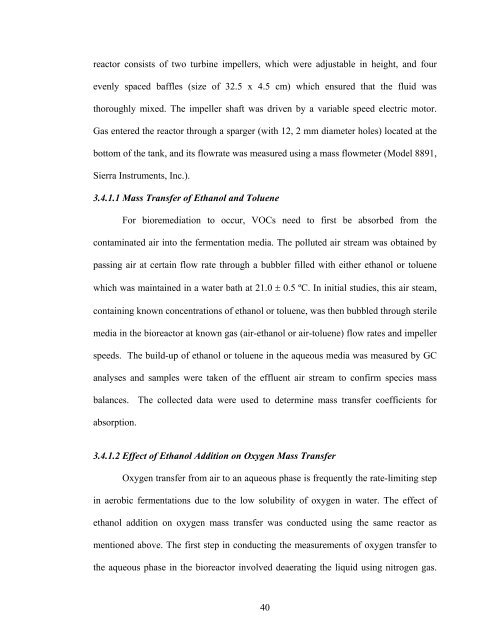Experimental Study of Biodegradation of Ethanol and Toluene Vapors
Experimental Study of Biodegradation of Ethanol and Toluene Vapors
Experimental Study of Biodegradation of Ethanol and Toluene Vapors
Create successful ePaper yourself
Turn your PDF publications into a flip-book with our unique Google optimized e-Paper software.
eactor consists <strong>of</strong> two turbine impellers, which were adjustable in height, <strong>and</strong> four<br />
evenly spaced baffles (size <strong>of</strong> 32.5 x 4.5 cm) which ensured that the fluid was<br />
thoroughly mixed. The impeller shaft was driven by a variable speed electric motor.<br />
Gas entered the reactor through a sparger (with 12, 2 mm diameter holes) located at the<br />
bottom <strong>of</strong> the tank, <strong>and</strong> its flowrate was measured using a mass flowmeter (Model 8891,<br />
Sierra Instruments, Inc.).<br />
3.4.1.1 Mass Transfer <strong>of</strong> <strong>Ethanol</strong> <strong>and</strong> <strong>Toluene</strong><br />
For bioremediation to occur, VOCs need to first be absorbed from the<br />
contaminated air into the fermentation media. The polluted air stream was obtained by<br />
passing air at certain flow rate through a bubbler filled with either ethanol or toluene<br />
which was maintained in a water bath at 21.0 ± 0.5 ºC. In initial studies, this air steam,<br />
containing known concentrations <strong>of</strong> ethanol or toluene, was then bubbled through sterile<br />
media in the bioreactor at known gas (air-ethanol or air-toluene) flow rates <strong>and</strong> impeller<br />
speeds. The build-up <strong>of</strong> ethanol or toluene in the aqueous media was measured by GC<br />
analyses <strong>and</strong> samples were taken <strong>of</strong> the effluent air stream to confirm species mass<br />
balances. The collected data were used to determine mass transfer coefficients for<br />
absorption.<br />
3.4.1.2 Effect <strong>of</strong> <strong>Ethanol</strong> Addition on Oxygen Mass Transfer<br />
Oxygen transfer from air to an aqueous phase is frequently the rate-limiting step<br />
in aerobic fermentations due to the low solubility <strong>of</strong> oxygen in water. The effect <strong>of</strong><br />
ethanol addition on oxygen mass transfer was conducted using the same reactor as<br />
mentioned above. The first step in conducting the measurements <strong>of</strong> oxygen transfer to<br />
the aqueous phase in the bioreactor involved deaerating the liquid using nitrogen gas.<br />
40















